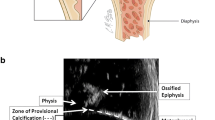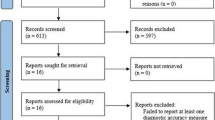Abstract
Background
Diagnosis of classic metaphyseal lesions (CMLs) in children suspected for child abuse can be challenging. Ultrasound (US) can potentially help diagnose CMLs. However, its accuracy is unknown.
Objective
To evaluate the accuracy of US in the diagnosis of CMLs using skeletal survey reports as the gold standard.
Materials and methods
US of the metaphysis was performed in three patient groups age <1 year. Informed consent was obtained for patients scheduled for renal US (Group 1) and for patients scheduled for skeletal surveys for possible child abuse (Group 2). Targeted US was also performed in selected patients to evaluate for possible CML suspected on radiographs (Group 3). In Groups 1 and 2, US was performed of both distal femurs, and of either the right or left proximal and distal tibia. Two radiologists (Rad1 and Rad2) independently reviewed the US studies, blinded to history and other imaging. US sensitivity and specificity were calculated using the following gold standards: CML definitely seen on skeletal survey (positive), CML definitely not seen on skeletal survey or part of renal US group (negative). Cases where the skeletal survey was indeterminate for CML were excluded. Kappa statistics were used to evaluate interobserver variability.
Results
Two hundred forty-one metaphyseal sites were evaluated by US in 63 children (mean age: 5 months; 33 males); 34 had skeletal surveys and 29 had renal US. Kappa for the presence of CML was 0.70 with 95.7% agreement. US sensitivity was 55.0% and 63.2% and the specificity was 97.7% and 96.7% for Rad1 and Rad2, respectively.
Conclusion
US has low sensitivity and high specificity in CML diagnosis. Thus, negative US does not exclude CML, but when the radiographs are equivocal, positive US can help substantiate the diagnosis.






Similar content being viewed by others
References
Lindberg DM, Beaty B, Juarez-Colunga E et al (2015) Testing for abuse in children with sentinel injuries. Pediatrics 136:831–838
Wood JN, Fakeye O, Feudtner C et al (2014) Development of guidelines for skeletal survey in young children with fractures. Pediatrics 134:45–53
Wood JN, Fakeye O, Mondestin V et al (2015) Development of hospital-based guidelines for skeletal survey in young children with bruises. Pediatrics 135:e312–e320
Perez-Rossello JM (2014) The AAP and the SPR child abuse committee issue a clinical report on 'Evaluating children with fractures for child physical abuse'. Pediatr Radiol 44:243
Berkowitz CD (2017) Physical abuse of children. N Engl J Med 376:1659–1666
Thackeray JD, Wannemacher J, Adler BH, Lindberg DM (2016) The classic metaphyseal lesion and traumatic injury. Pediatr Radiol 46:1128–1133
Tsai A, McDonald AG, Rosenberg AE et al (2014) High-resolution CT with histopathological correlates of the classic metaphyseal lesion of infant abuse. Pediatr Radiol 44:124–140
Kleinman PK, Perez-Rossello JM, Newton AW et al (2011) Prevalence of the classic metaphyseal lesion in infants at low versus high risk for abuse. AJR Am J Roentgenol 197:1005–1008
Eide P, Djuve A, Myklebust R et al (2019) Prevalence of metaphyseal injury and its mimickers in otherwise healthy children under two years of age. Pediatr Radiol 49:1051–1055
Kleinman PK (2008) Problems in the diagnosis of metaphyseal fractures. Pediatr Radiol 38(Suppl 3):S388–S394
Ravichandiran N, Schuh S, Bejuk M et al (2010) Delayed identification of pediatric abuse-related fractures. Pediatrics 125:60–66
Bainbridge JK, Huey BM, Harrison SK (2015) Should bone scintigraphy be used as a routine adjunct to skeletal survey in the imaging of non-accidental injury? A 10 year review of reports in a single Centre. Clin Radiol 70:e83–e89
Perez-Rossello JM, Connolly SA, Newton AW et al (2010) Whole-body MRI in suspected infant abuse. AJR Am J Roentgenol 195:744–750
Drubach LA, Johnston PR, Newton AW et al (2010) Skeletal trauma in child abuse: detection with 18F-NaF PET. Radiology 255:173–181
Markowitz RI, Hubbard AM, Harty MP et al (1993) Sonography of the knee in normal and abused infants. Pediatr Radiol 23:264–267
Marine MB, Hibbard RA, Jennings SG, Karmazyn B (2019) Ultrasound findings in classic metaphyseal lesions: emphasis on the metaphyseal bone collar and zone of provisional calcification. Pediatr Radiol 49:913–921
Pfeifer CM, Hammer MR, Mangona KL, Booth TN (2017) Non-accidental trauma: the role of radiology. Emerg Radiol 24:207–213
Kleinman PK, Sarwar ZU, Newton AW et al (2009) Metaphyseal fragmentation with physiologic bowing: a finding not to be confused with the classic metaphyseal lesion. AJR Am J Roentgenol 192:1266–1268
Quigley AJ, Stafrace S (2014) Skeletal survey normal variants, artefacts and commonly misinterpreted findings not to be confused with non-accidental injury. Pediatr Radiol 44:82–93
Anilkumar A, Fender LJ, Broderick NJ et al (2006) The role of the follow-up chest radiograph in suspected non-accidental injury. Pediatr Radiol 36:216–218
Harlan SR, Nixon GW, Campbell KA et al (2009) Follow-up skeletal surveys for nonaccidental trauma: can a more limited survey be performed? Pediatr Radiol 39:962–968
Harper NS, Eddleman S, Lindberg DM, Investigators ESTRA (2013) The utility of follow-up skeletal surveys in child abuse. Pediatrics 131:e672–e678
Karmazyn B, Duhn RD, Jennings SG et al (2012) Long bone fracture detection in suspected child abuse: contribution of lateral views. Pediatr Radiol 42:463–469
Barber I, Perez-Rossello JM, Wilson CR, Kleinman PK (2015) The yield of high-detail radiographic skeletal surveys in suspected infant abuse. Pediatr Radiol 45:69–80
Author information
Authors and Affiliations
Corresponding author
Ethics declarations
Conflicts of interest
None
Additional information
Publisher’s note
Springer Nature remains neutral with regard to jurisdictional claims in published maps and institutional affiliations.
Electronic supplementary material
ESM 1
(PDF 283 kb)
Rights and permissions
About this article
Cite this article
Karmazyn, B., Marine, M.B., Wanner, M.R. et al. Accuracy of ultrasound in the diagnosis of classic metaphyseal lesions using radiographs as the gold standard. Pediatr Radiol 50, 1123–1130 (2020). https://doi.org/10.1007/s00247-020-04671-8
Received:
Revised:
Accepted:
Published:
Issue Date:
DOI: https://doi.org/10.1007/s00247-020-04671-8




